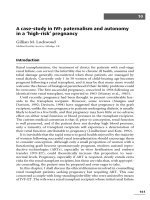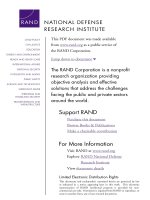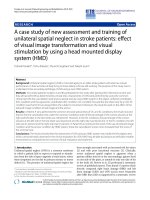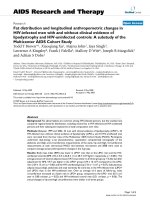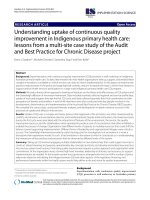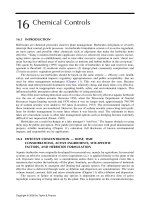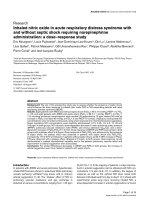Network-Centric Operations Case Study - Air-to-Air Combat With and Without Link 16 pdf
Bạn đang xem bản rút gọn của tài liệu. Xem và tải ngay bản đầy đủ của tài liệu tại đây (3.03 MB, 144 trang )
This PDF document was made available
from www.rand.org as a public service of
the RAND Corporation.
6
Jump down to document
Visit RAND at www.rand.org
Explore RAND National Defense
Research Institute
View document details
This document and trademark(s) contained herein are protected by law
as indicated in a notice appearing later in this work. This electronic
representation of RAND intellectual property is provided for non-
commercial use only. Permission is required from RAND to reproduce, or
reuse in another form, any of our research documents.
Limited Electronic Distribution Rights
For More Information
CHILD POLICY
CIVIL JUSTICE
EDUCATION
ENERGY AND ENVIRONMENT
HEALTH AND HEALTH CARE
INTERNATIONAL AFFAIRS
NATIONAL SECURITY
POPULATION AND AGING
PUBLIC SAFETY
SCIENCE AND TECHNOLOGY
SUBSTANCE ABUSE
TERRORISM AND
HOMELAND SECURITY
TRANSPORTATION AND
INFRASTRUCTURE
The RAND Corporation is a nonprofit
research organization providing
objective analysis and effective
solutions that address the challenges
facing the public and private sectors
around the world.
Purchase this document
Browse Books & Publications
Make a charitable contribution
Support RAND
This product is part of the RAND Corporation monograph series.
RAND monographs present major research findings that address the
challenges facing the public and private sectors. All RAND mono-
graphs undergo rigorous peer review to ensure high standards for
research quality and objectivity.
Daniel Gonzales, John Hollywood,
Gina Kingston, David Signori
Prepared for the Office of Force Transformation in the
Office of the Secretary of Defense
Approved for public release; distribution unlimited
Network-Centric
Operations
Case Study
Air-to-Air Combat With
and Without Link 16
The RAND Corporation is a nonprofit research organization providing
objective analysis and effective solutions that address the challenges
facing the public and private sectors around the world. RAND’s
publications do not necessarily reflect the opinions of its research clients
and sponsors.
R
®
is a registered trademark.
© Copyright 2005 RAND Corporation
All rights reserved. No part of this book may be reproduced in any
form by any electronic or mechanical means (including photocopying,
recording, or information storage and retrieval) without permission in
writing from RAND.
Published 2005 by the RAND Corporation
1776 Main Street, P.O. Box 2138, Santa Monica, CA 90407-2138
1200 South Hayes Street, Arlington, VA 22202-5050
201 North Craig Street, Suite 202, Pittsburgh, PA 15213-1516
RAND URL: />To order RAND documents or to obtain additional information, contact
Distribution Services: Telephone: (310) 451-7002;
Fax: (310) 451-6915; Email:
The research described in this report was prepared for the Office of
Force Transformation in the Office of the Secretary of Defense (OSD).
The research was conducted in the RAND National Defense Research
Institute, a federally funded research and development center supported
by the OSD, the Joint Staff, the unified commands, and the defense
agencies under Contract DASW01-01-C-0004.
Library of Congress Cataloging-in-Publication Data
Network-centric operations case study : air-to-air combat with and without Link 16 /
Dan Gonzales [et al.].
p. cm.
“MG-268.”
Includes bibliographical references.
ISBN 0-8330-3776-5 (pbk. : alk. paper)
1. Fighter plane combat—United States—Evaluation. 2. United States. Air
Force—Communication systems—Evaluation. 3. Fighter planes—Computer
networks—Evaluation. I. Gonzales, Daniel, 1956–
UG703.N48 2005
358.4'34—dc22
2005006002
iii
Preface
The Office of Force Transformation (OFT) and the Office of the
Assistant Secretary of Defense for Networks and Information Integra-
tion (OASD [NII]) have developed a conceptual framework for con-
ducting analyses and enhancing understanding of network-centric
operations (NCO) capabilities. RAND is one of the supporting orga-
nizations that assisted the Office of the Secretary of Defense in devel-
oping the NCO Conceptual Framework (NCO CF). The NCO CF
has several objectives: to provide a better understanding of key NCO
attributes and their interrelationships; to provide metrics to measure
progress in developing transformed, network-centric forces; and to
help understand and articulate how NCO capabilities can be a source
of combat power.
RAND has applied the NCO CF to the air-to-air combat mis-
sion. We used the framework to examine the results of the Joint Tac-
tical Information Distribution System (JTIDS) Operational Special
Project. This project examined the performance of tactical fighter air-
craft (F-15s) equipped with Link 16 data communications terminals
and found that F-15s equipped with Link 16 were significantly more
effective in air combat than F-15s equipped with only voice commu-
nications.
This report describes the results of the case study that involved
analyzing the capabilities of Link 16 data and voice communications
networks, conducting interviews with experienced fighter pilots, and
iv NCO Case Study: Air-to-Air Combat With and Without Link 16
building a quantitative model to calculate NCO CF metrics for mis-
sion capability packages designed for the air-to-air combat mission.
This case study provides useful insights into the application of
the NCO CF and associated metrics. The report highlights the
advantages NCO capabilities can potentially provide U.S. air forces
in the air superiority mission. It also demonstrates the feasibility of
applying the NCO CF in a quantitative fashion to the chain of infer-
ences contained in the network-centric warfare hypothesis. This
report should be of use as a starting point for those seeking to use the
NCO CF to analyze the impact of NCO capabilities in more compli-
cated military mission areas.
This research was conducted for OFT within the Acquisition
and Technology Policy Center of the RAND National Defense
Research Institute (NDRI). NDRI is a federally funded research and
development center sponsored by the Office of the Secretary of
Defense, the Joint Staff, the unified commands, and the defense
agencies.
For more information on RAND’s Acquisition and Technology
Policy Center, contact the Director, Philip Antón. He can be reached
by e-mail at ; by phone at 310-393-0411,
extension 7798; or by mail at RAND, 1776 Main Street, Santa Mon-
ica, CA, 90407-2138. More information about RAND is available at
www.rand.org.
v
Contents
Preface iii
Figures
ix
Tables
xiii
Summary
xv
Acknowledgments
xxxiii
Abbreviations
xxxv
CHAPTER ONE
Introduction 1
Overview
1
The NCO Conceptual Framework
3
The JTIDS Operational Special Project and an Example Air Combat
Mission
7
Outline of the Report
10
CHAPTER TWO
Methodology 11
Application of the NCO CF
11
Approach to Measurement in the Case Study
14
CHAPTER THREE
Force Characteristics 19
MCP 1: Voice Communications Only
19
MCP 2: Link 16 Networking
22
vi NCO Case Study: Air-to-Air Combat With and Without Link 16
CHAPTER FOUR
Quality of Organic Information 25
Input Factors and Specific Metrics
25
Inputs, Calculations, and Individual Platform Results
26
Overall Results
30
CHAPTER FIVE
Degree of Networking 31
Specific Metrics
31
Inputs, Calculations, and Individual Platform Results
31
Overall Results
35
CHAPTER SIX
Degree of Information “Share-Ability” 37
Specific Metrics
37
Inputs
38
Calculations
39
Individual Platform Results
42
Overall Results
43
CHAPTER SEVEN
Quality of Individual Information 45
Specific Metrics
45
Inputs
46
Calculations
48
Individual Platform Results
49
Overall Results
51
CHAPTER EIGHT
Degree of Shared Information 53
Specific Metrics, Inputs, and Calculations
53
Individual Platform Results
54
Overall Results
55
Contents vii
CHAPTER NINE
Quality of Individual Sense-Making: Awareness 57
Major Factors Contributing to Individual Sense-Making
57
Specific Metrics, Inputs, and Calculations
59
Individual Platform Results
60
Overall Results
61
CHAPTER TEN
Quality of Individual Sense-Making: Decisionmaking 63
Major Factors Contributing to Individual Decisionmaking
63
Specific Metrics, Inputs, and Calculations
68
Results
69
Linking Decisionmaking to Mission Effectiveness
71
CHAPTER ELEVEN
Conclusions 75
Summary
75
Lessons Learned from Applying the NCO CF to the Air-to-Air
Case Study
77
Areas for Further Research
80
APPENDIX
Analytica Model for the Air-to-Air Combat Example 83
Bibliography
105
ix
Figures
S.1. The NCO Conceptual Framework and Its Application to Air-to-
Air Combat
xvii
S.2. Typical Voice Channel Connectivity
xx
S.3. Link 16 Network Connectivity
xxi
S.4. Early Stages of a Tactical Engagement
xxiii
S.5. Comparing Quality of Shared Individual Information
Across MCPs
xxv
S.6. Decision Speed and Competitive Advantage with Link 16
xxvii
S.7. Improved Air-to-Air Tactics Execution Enabled by Improved
Awareness
xxviii
S.8. Summary Comparison of MCPs Using Average Scores
xxx
1.1. Top Level of the NCO Conceptual Framework
4
1.2. Air-to-Air Scenario Exemplar
9
2.1. The NCO Framework and Corresponding Data Available for the
Case Study
12
2.2. Concepts Included in the Case Study
13
2.3. An Array Tracking Pilots’ Knowledge of Sensed Air Tracks
16
2.4. An Array Tracking Pilots’ Knowledge of Fixed Air Tracks
17
3.1. Voice Channel Networks for MCP 1
20
3.2. The Link 16 Network for MCP 2
23
4.1. Factors Potentially Involved in Computing Quality of Organic
Information
26
4.2. Quality of Organic Information for Threat (Red) Tracks
27
4.3. Quality of Organic Information for Blue Tracks
29
x NCO Case Study: Air-to-Air Combat With and Without Link 16
4.4. Overall MCP Scores for Quality of Individual Information 30
5.1. Overall MCP Scores for Degree of Networking
36
6.1. Factors Impacting Quality of Retrievable Information
38
6.2. Percentage of Information Retrieved by Timeliness Band
43
6.3. Comparing MCP Scores for Degree of Information “Share-
Ability”
44
7.1. Factors Affecting Quality of Organic Information
46
7.2. Comparing Quality of Individual Information Across MCPs
50
7.3. Overall MCP Scores for Quality of Individual Information
52
8.1. Comparing Degree of Shared Information Across MCPs
54
8.2. Overall MCP Scores for Quality of Shared Information
56
9.1. Major Factors Contributing to Individual Sense-Making
58
9.2. Comparing Quality of Individual Awareness Across MCPs
60
9.3. Overall MCP Scores for Quality of Individual Awareness
61
10.1. Factors Contributing to Quality of Individual
Decisionmaking
64
10.2. Decision Speed and Competitive Advantage with Link 16
66
10.3. Improved Air-to-Air Tactics Execution Enabled by Improved
Awareness
67
10.4. Sense-Making Requirements Met by the MCPs
70
10.5. Overall MCP Scores for Quality of Individual
Decisionmaking
71
10.6. Overall MCP Scores for Mission Effectiveness
73
11.1. Complete Comparison of MCPs Using Summary Metrics
76
A.1. Top Level of the Analytica Model
84
A.2. Types of Nodes in Analytica
85
A.3. Air-to-Air Model Array Dimensions
86
A.4. An Example Input Array
88
A.5. Data Placement Node (Force Module)
90
A.6. Quality of Organic Information
91
A.7. Degree of Networking
92
A.8. Quantity of Data Posted
94
A.9. Quantity of Data Retrieved
96
A.10. Quality of Individual Information
97
Figures xi
A.11. A Quality of Individual Information Array 99
A.12. Degree of Shared Information
100
A.13. Quality of Individual Awareness
102
A.14. Quality of Individual Decisions
103
xiii
Tables
S.1. Results of the JTIDS Operational Special Project xxix
1.1. Subsidiary Attributes for Quality of Information
6
1.2. Results of the JTIDS Operational Special Project
8
4.1. Table of Metric Scores by Track Latency
28
5.1. Degree of Networking Metrics for MCP 1 (Voice Only)
32
5.2. Degree of Networking Metrics for MCP 1 (Link 16)
34
6.1. Inputs to Quantity of Retrievable Information
40
7.1. Inputs to Quality of Individual Information Metrics
47
10.1. Sense-Making Requirements to Employ Advanced Tactics
(Notional)
69
10.2. Results of the JTIDS Operational Special Project (Average Red-
to-Blue Loss Exchange Ratios)
72
xv
Summary
In the mid-1990s, the U.S. Air Force at the request of Congress con-
ducted the Joint Tactical Information Distribution System (JTIDS)
Operational Special Project. In this exercise, the capabilities of F-15
air superiority aircraft equipped with voice-only communications
were compared with F-15s equipped with voice and JTIDS Link 16
data link communications in tactical air-to-air combat. More than
12,000 sorties were flown in this special project. Blue offensive coun-
terair packages composed of these F-15s ranged in size from two to
eight aircraft. In all cases, the packages were controlled and cued by
Airborne Warning and Control System (AWACS) aircraft. The size
of the engagements ranged from two Blue fighters on two Red fight-
ers to eight Blue fighters on 16 Red fighters. Engagements occurred
during daylight and night conditions. The primary independent
variable was whether the Blue F-15s were equipped with the Link 16
data link or with conventional voice communications only. The
capability of the Red aircraft remained consistent during the project.
On average, Blue offensive counterair packages equipped with
Link 16 achieved a two-and-a-half times improvement in kill ratio
(Red aircraft to Blue aircraft “destroyed”), both during the day and at
night. However, it was unclear how and why this significant improve-
ment in force effectiveness arose. The aim of this study is to under-
stand whether this increase in combat effectiveness stemmed from the
network-centric capabilities of F-15 aircraft equipped with Link 16
and fighter pilots able to effectively use data link communications.
xvi NCO Case Study: Air-to-Air Combat With and Without Link 16
The original Network-Centric Warfare (NCW) hypothesis pos-
its the following relationships between twenty-first century informa-
tion technologies, information sharing, and warfighting capabilities:
• “A robustly networked force improves information sharing
• “Information sharing enhances the quality of information and
shared situational awareness
• “Shared situational awareness enables self-synchronization, and
enhances sustainability and speed of command
• “These, in turn, dramatically increase mission effectiveness.”
(Alberts and Garstka, 2001.)
The Network-Centric Operations Conceptual Framework
(NCO CF), developed by Office of Force Transformation (OFT)
and the Office of the Assistant Secretary of Defense for Networks and
Information Integration (OASD [NII]), provides a more detailed and
precise elaboration of the NCW hypotheses.
1
It includes NCO capa-
bility concepts (such as the degree of networking, degree of informa-
tion sharing, and situational awareness) and hypotheses for how these
concepts relate to and influence each other. The result is an inter-
linked set of NCO capabilities that describe how they in combination
can lead to improvements in overall military force effectiveness.
Importantly, the NCO CF describes subsidiary attributes and metrics
for assessing NCO capability concepts, making it possible to deter-
mine whether and how possession of a particular NCO capability
relates to improvements in force effectiveness. Figure S.1 shows a top-
level view of the NCO CF, including its top-level NCO capability
concepts and the hypothesized interactions between them.
2
All link-
ages reflect positive relationships; for example, it is hypothesized that
____________
1
Note that we use the terms NCO and NCW interchangeably in this report.
2
The NCO CF is described in Signori et al. (2002); Evidence Based Research, Inc. (EBR)
(2003); and Signori et al. (2004). Major concepts of NCO are described in Alberts, Garstka,
and Stein (1999) and Alberts et al., (2001).
Summary xvii
an improvement in the quality of information will improve the qual-
ity of situational awareness.
OFT and OASD (NII) tasked RAND to undertake a study to
apply the NCO CF to the air-to-air combat mission. The primary
objective of this case study is to understand whether the relationships
between NCO capabilities hypothesized to exist in the NCO CF are
valid for this particular military mission area and to determine how
NCO capability improvements may lead to increases in military force
effectiveness in air-to-air combat. In other words, our purpose was to
“learn by doing” by applying the NCO conceptual framework to a
specific mission.
Figure S.1
The NCO Conceptual Framework and Its Application to Air-to-Air Combat
Degree of actions/entities synchronization
Degree of decision/plan synchronization
Degree of effectiveness
RAND MG268-S.1
Information
sources
Value-added
services
C2 Effectors
Force
Quality of organic
information
Degree of shared information
Degree of information “share-ability”
Degree of networking
Quality of individual
information
Quality of individual
sensemaking
Quality of
interactions
Understanding
Awareness
Decisions
Degree of shared sensemaking
Understanding
Awareness
Decisions
Concept included
in case study
Concept not
included in case
study
1
2 3
5 4
6
7
8
xviii NCO Case Study: Air-to-Air Combat With and Without Link 16
The air-to-air combat mission was chosen as an initial case study
because it can involve relatively simple tactical engagement situations
with a small number of aircraft. We anticipated it would be relatively
easy to apply the NCO CF to simple tactical engagements. We were
also fortunate that a source of quantitative force effectiveness data was
available for this mission area. We were able to utilize data from the
Joint Tactical Information Distribution System (JTIDS) Operational
Special Project (Hq. USAF, 1997). Of particular interest is that the
JTIDS project found that fighter aircraft in air-to-air engagements
were significantly more effective when equipped with the Link 16
datalink than when equipped solely with voice communications. Spe-
cifically, Link 16–equipped fighters saw approximately a two-and-a-
half times improvement in the kill ratio (Red aircraft to Blue aircraft
shot down), both during daylight and nighttime conditions. This
report examines whether the NCO CF can explain this major
increase in mission effectiveness.
Figure S.1 showed the NCO CF top-level concepts that serve as
the foundation for this case study, with the numbers indicating the
order in which they are addressed in this report. The components of
individual sense-making are shaded separately: we incorporate the
quality of individual awareness and quality of decisions concepts but
not the quality of individual understanding concept. Other concepts
we focused on relate to physical NCO capabilities–notably the degree
of networking and the resulting quality of information the pilots
obtained from their organic sensors as well as from the network to
which they are connected (see the various information concepts listed
in Figure S.1). On the other hand, we did not employ the quality of
interactions or sense-making concepts because we lacked data for
these measures at the time the study was conducted. It is important to
note that these concepts represent activities that take place in the
cognitive domain (i.e., mental processes) and the social domain (i.e.,
interactions, such as conversations, between warfighters) and are dif-
ficult to evaluate directly.
Summary xix
Mission Capability Packages and Networking.
In the live flight operational exercises examined as part of the JTIDS
Operational Special Project, F-15 fighter packages of two to eight
aircraft flew against equal size or larger packages of enemy aircraft.
We shall designate these fighter aircraft packages mission capability
packages (MCPs).
Two alternative Blue MCPs flew against the same Red MCPs in
these live flight exercises. The Blue MCPs had different networking
capabilities but were otherwise identical. One Blue MCP was
equipped with the Link 16 digital data communications network,
while the other had only voice communications. The Red fighters
that participated in these live flight operational exercises had voice
only communications.
Voice Networks
Figure S.2 illustrates the voice channel structure typically employed
by Air Force fighters, in this case for an MCP with four fighters.
Pilots each monitor two separate voice channels. AWACS broadcasts
aircraft track information on Channel 1 to the Blue aircraft. The four
fighter aircraft communicate among themselves on Channel 2. Each
fighter pilot listens to two channels at a time, and only one aircraft
pilot can speak on a channel at a time.
Air Force pilots have developed a voice coding scheme that
allows pilots and AWACS flight controllers to transmit approximately
one aircraft track about three times every ten seconds. We use ten
seconds as the air picture track update cycle time because this is the
rate at which the AWACS radar antenna rotates or performs one
complete surveillance cycle of the battlespace. So, in principle, F-15
fighter pilots can receive updated air track information from AWACS
every ten seconds, if AWACS flight controllers have the time to ver-
bally transmit this information over the voice network every radar
sweep and if there is “time available” to transmit the information over
xx NCO Case Study: Air-to-Air Combat With and Without Link 16
Figure S.2
Typical Voice Channel Connectivity
RAND MG268-S.2
Channel 1:
AWACS control
Channel 2: intraflight communications
AWACS
Channel 1
Channel 2
Blue 11
Package lead
Blue 14
Wingman
Blue 13
Flight lead
Blue 12
Wingman
the voice channel (i.e., if there is no contention for the voice chan-
nel).
The pilots must interpret the spoken information they receive
on their voice radios and build a mental three-dimensional “picture”
of the positions and velocities of reported aircraft. This is known as
developing situational awareness of the battlespace and is a persistent
activity because of the dynamic nature of air combat. While fighter
pilots generally have the mental ability to keep air track information
in their minds for long periods, the utility of this information
decreases as an air track “age” grows. An air track with an age of ten
seconds or more has little utility because the pilot will have only a
vague idea where the fast-moving jet fighter may be (the object that
corresponds to the air track), especially at close ranges. We approxi-
mate the process of removing old information from a fighter pilot’s
mental map or “common operational picture” of the battlespace in
the following way: air tracks older than the AWACS update rate are
“dropped” on the grounds that the tracked plane will have moved far
enough in ten seconds to make the pilot’s mental air track position
Summary xxi
and velocity estimate too inaccurate to be useful in a high-speed tacti-
cal air combat engagement.
Link 16 Data Communications Network
Link 16 is a wireless data communications system that provides air
track and other information to fighter aircraft, other weapons plat-
forms, and command and control (C2) nodes equipped with JTIDS
and Multifunctional Information Distribution System (MIDS) com-
munications terminals. Link 16 uses a time-division multiple access
(TDMA) wireless network structure and a jam-resistant, frequency-
hopping waveform. This networking structure is illustrated in Figure
S.3. In this type of network, each participant (or network node) can
receive all transmissions made by other network participants.
Fighters equipped with Link 16 can receive air track informa-
tion from other neighboring fighter aircraft and from AWACS (if
AWACS is within a line of sight of the fighter). A Link 16 network is
composed of 128 time slots per second, with each slot capable of
Figure S.3
Link 16 Network Connectivity
RAND MG268-S.3
One net
128 time
slots per
second
xxii NCO Case Study: Air-to-Air Combat With and Without Link 16
describing a single airplane track to a high degree of accuracy. Link
16 air tracks received by a particular fighter from other aircraft are
shown on a display screen in the cockpit along with air tracks
detected by the aircraft’s organic sensors. Therefore, each fighter pilot
in a Link 16–equipped MCP can display nearly the same air track
information or the same picture of the battlespace.
Information “Share-Ability” and Quality of Information
The “degree of information share-ability” concept describes how well
individual pieces of information can be shared through use of the
MCP’s networking capabilities. In comparison to voice-only com-
munications, the Link 16 network acts as an information multiplier;
what is detected by one aircraft (either by AWACS or by a fighter) is
immediately shared with all other fighters in the MCP precisely and
in near real time. In contrast, voice transmissions are relatively slow
(maximum of three track updates every ten seconds across an MCP
voice channel), meaning that only a small fraction of the detected
information can be shared. Further, voice communications introduce
errors, either in the verbal communications themselves or because of
radio noise or interference.
Consider the early stages of an air-to-air combat engagement
shown in Figure S.4. In the tactical engagement, four Blue fighters
engage four Red fighters. The four Blue fighters are provided threat
warning information by AWACS and may be vectored by AWACS to
engage particular threat aircraft. The figure illustrates the “opening
gambit,” or early stages of the engagement, which is a key part of the
engagement recognized as strongly influencing the final outcome, as
the Blue aircraft have an opportunity to maneuver for highly advan-
tageous positions prior to engaging the Red aircraft directly. Here,
the AWACS aircraft has radar coverage of the entire battlespace. Two
of the Blue fighters (Blue 11 and Blue 12) have radar locks on two of
the Red fighters (Red 1 and 2). Two of the Red aircraft (Red 3 and 4)
Summary xxiii
are out of radar range for any of the Blue fighters and are on the very
edge of the battlespace but are approaching their attack positions
rapidly and are detected by AWACS.
We calculated the quality of information across the MCP for the
engagement geometry shown in Figure S.4, for both an MCP with
Link 16 and an MCP with voice-only communications. Note the use
of the term “information” to indicate that it includes information
available to the pilot of a particular aircraft from both organic sensors
and the network. Figure S.5 compares quality of information scores
for each Blue aircraft in both the voice-only and Link 16–equipped
MCPs along four metrics (all normalized between zero and one):
• Completeness (Detection) is the percentage of all air tracks in
the engagement (four Red and five Blue aircraft) that the Blue
Figure S.4
Early Stages of a Tactical Engagement
RAND MG268-S.4
Blue
13 and 14
Blue
11 and 12
AWACS
Red 1, 2
Red 3, 4
